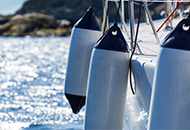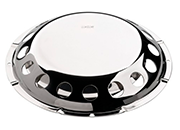
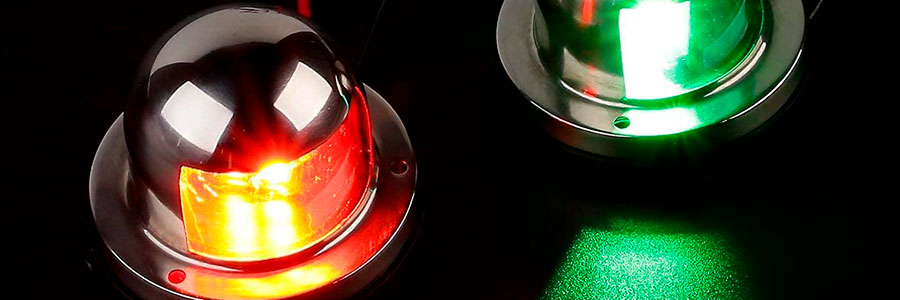
Navigating the waters after dark or in conditions of reduced visibility without the proper navigation lights isn’t just dangerous—it's against international maritime regulations. Authorities worldwide, including organizations like the International Maritime Organization (IMO), establish clear guidelines for marine navigation lighting to ensure the safety of all vessels and their passengers. Whether cruising the open ocean or a serene lake, understanding and adhering to these lighting regulations is paramount for safe and lawful boating globally. Boat navigation lights are essential for vessels of all sizes, indicating their presence and direction to other boats in the area. These lights must meet specific requirements outlined in navigation rules and regulations, ensuring visibility and compliance with international standards.
General Boat Navigation Light Requirements for All Vessels: Navigating with Lights
The serene beauty of sailing under a starlit sky can quickly turn into a perilous endeavor without the guiding clarity of proper navigation lights. Governed by stringent regulations, these lights are not merely accessories but are vital for the safety of all maritime vessels. Let’s delve into the general requirements that apply to all vessels to ensure a safe passage in the twilight hours or amidst the cloak of reduced visibility.
Understanding the Language of Lights
Navigation lights communicate essential information about a vessel's presence, orientation, and activity to others on the water. This luminous dialogue is crucial for preventing collisions and ensuring harmonious navigation. Here are the foundational elements of this lighting system:
- All-Around Lights: These sentinel lights emit a continuous white glow, visible across a full 360-degree spectrum. Their purpose is to announce the vessel's presence in all directions, acting as a beacon to others in the vicinity. Required to be visible for a distance of at least 2 miles, they serve as the most basic form of maritime communication.
- Masthead Lights: Like the vigilant eyes of the vessel, masthead lights are white and cast their gaze from the port side, across the bow, to the starboard side, covering an arc of 225 degrees. Positioned above the vessel's sidelights, they must be placed in a manner that ensures their visibility for 2 miles for vessels under 39.4 feet, and 3 miles for those over. These lights signal the vessel's forward orientation and are a critical element for understanding a boat's direction.
- Sidelights: These are the chromatic narrators of the vessel's sides. With red lights adorning the port and green on the starboard, they shine from dead ahead to 112.5 degrees aft on either side. This color-coded system helps identify the direction of oncoming vessels, ensuring that navigators can make informed decisions to avoid collisions. The visibility range for these lights is set at 1 mile for boats under 39.4 feet and 2 miles for larger vessels.
- Stern Lights: Casting a white light over an arc of 135 degrees from the stern, these lights offer a clear indication of the vessel's rear aspect. Their glow is a guidepost for vessels approaching from behind, signaling the boat's direction and ensuring a safe distance is maintained. Stern lights share the 2-mile visibility requirement, serving as a crucial component of the vessel's navigational lighting ensemble.
The Choreography of Compliance
Adhering to these lighting requirements is not just about regulatory compliance; it's a matter of safety and responsibility. Whether cruising along a peaceful lake or navigating the open seas, the proper use of navigation lights ensures that all mariners can share the waters safely and confidently. Every light serves a purpose, every color tells a story, and together, they create a ballet of beams that guide vessels through the night.
In compliance with navigation light rules and requirements, vessels must ensure proper positioning and visibility of masthead lights, side lights, and white stern lights to meet legal requirements. These lights play a crucial role in indicating the vessel's orientation and direction, ensuring safe navigation, especially between sunset and sunrise. Understanding navigation light rules and regulations handbook is essential for boat owners to interpret and exhibit the lights correctly, contributing to a safer maritime environment for all.
To navigate safely and in accordance with maritime laws, each vessel, regardless of size, must maintain a system of navigation lights that meets specific types and requirements. These include the all-round boat anchor light, which must be visible for at least two nautical miles and is required when a boat is at anchor to signal its presence. Additionally, the boat must display a combination of red and green sidelights and a white stern light when underway, ensuring a full circle of light that enhances visibility from all angles.
The masthead light, which should be positioned on the centerline of the boat forward, serves as a critical component by shining over a white stern light, clearly indicating the vessel's orientation and direction. This light setup must be visible between sunset and sunrise or during any period of reduced visibility. For sailboats, a tricolor light can be used as a substitute for the separate sidelights and stern light, providing a compact and visible solution that meets navigation light requirements.
In the realm of maritime navigation, lights do more than illuminate; they communicate, protect, and unite. By understanding and respecting the general requirements for all vessels, boaters contribute to a safer, more harmonious maritime community.
Furthermore, understanding and correctly displaying these lights—whether they are regular navigation lights or portable navigation lights for smaller boats—ensures compliance with the "rules of the road" at sea. This knowledge of navigation not only prevents accidents but also promotes a culture of safety and responsibility among all mariners, making the waters safer for everyone navigating them.
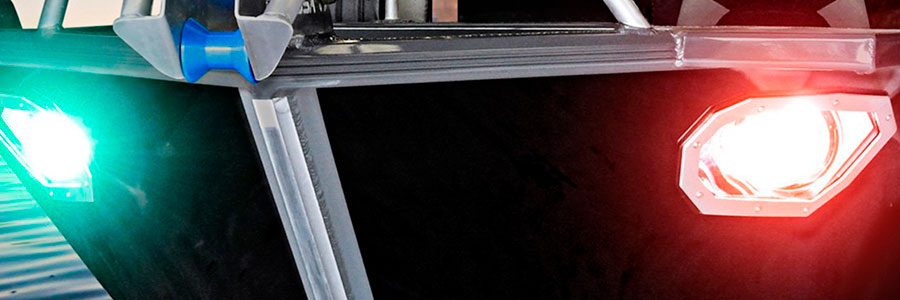
Specific Requirements for Power Boats: What Type of Boat Requires Navigation Lights for Illuminating Safety and Compliance
Powerboats, with their ability to swiftly cut through water, are bound by specific navigation light requirements designed to enhance visibility and prevent collisions. These regulations, dictated by marine authorities, take into account the unique profiles and operational characteristics of power-driven vessels. Let’s navigate through the specific requirements that powerboat operators must adhere to when voyaging from dusk till dawn or during periods of reduced visibility.
A Spectrum of Signals for Safe Navigation: Types and Requirements.
The choreography of lights for powerboats is meticulously defined, ensuring that each vessel can signal its presence, orientation, and activity effectively. Here are the key components:
- Masthead Light: The masthead light, a beacon of white located at the forefront of the vessel, serves as a crucial indicator of a powerboat's presence and direction.
- Sidelights: Serving as the chromatic guides to a powerboat's orientation, the sidelights feature a green light on the starboard side and a red light on the port side.
- Stern Light: The stern light, a solitary white beam positioned at the rear, covers an expansive 135-degree arc, illuminating the vessel’s path for those trailing behind.
Adaptable Lighting for Compact Powerboats
For powerboats under 12 meters in length, there’s an allowance for an adaptive approach to navigation lighting:
- An all-around white light may substitute the combination of a masthead light and stern light, offering a 360-degree beacon of visibility. This simplification caters to the compact profile of smaller powerboats while maintaining a high standard of visibility and safety.
Great Lakes Specificity
On the Great Lakes, powerboats may carry an all-around white light in lieu of the standard masthead and stern light combination. This regional adaptation acknowledges the unique boating conditions and traditions of the Great Lakes, allowing for a tailored approach to navigation lighting that still adheres to the overarching goal of maritime safety.
To meet boat navigation light rules and ensure compliance, powerboat operators must ensure the proper positioning and visibility of masthead lights, sidelights, and white stern lights. These lights play a critical role in indicating the power boat's orientation and direction, facilitating safe navigation, especially between sunset and sunrise. Understanding navigation rules and regulations handbook is essential for operators to interpret and exhibit the lights correctly, contributing to a safer marine environment for all.
For powerboat operators, adhering to these specific lighting requirements is not just a matter of legal compliance; it’s a commitment to the safety and well-being of all who share the waterways. By properly outfitting their vessels with the appropriate lights, powerboaters contribute to a safer, more navigable marine environment, where the joy of boating can be pursued with confidence and peace of mind.
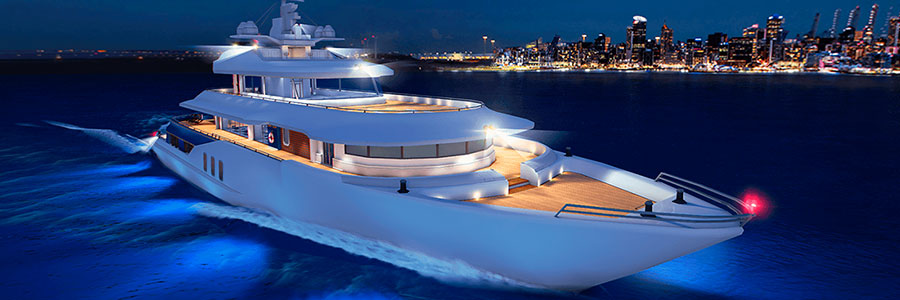
Basic Rules for Sailboats: Navigating Night Seas with Precision and Safety
Sailboats, with their serene grace and reliance on the whims of the wind, have a set of navigation light requirements tailored to their unique operation. These standards, mandated to enhance safety and visibility, ensure that sailboats can be seen and their actions anticipated by other vessels in low light or reduced visibility conditions.
The Essential Luminous Guide
The configuration of navigation lights for sailboats is designed with the intention of clearly signaling their presence, orientation, and mode of propulsion to nearby vessels. Here’s a breakdown of the requirements:
- Sidelights: As with powerboats, sailboats must also display sidelights. These consist of a green light on the starboard side and a red light on the port side, each casting an arc of visibility from dead ahead to 112.5 degrees aft on their respective sides. The intent is to indicate the direction the sailboat is facing and moving towards.
- Stern Light: This white light shines aft and to each side, creating a 135-degree arc of visibility that effectively marks the sailboat’s rear aspect to other seafarers. A visibility range of 2 miles ensures that the sailboat’s position is communicated clearly to vessels approaching from behind.
Flexibility of Boat Navigation Light Types for Smaller Vessels
Sailboats under 7 meters in length operate under slightly modified rules due to their size and operational constraints:
- Alternate Lighting Options: While these sailboats are encouraged to adhere to the standard lighting configurations, practical challenges may necessitate alternatives.
Operators’ Responsibility
The safe navigation of a sailboat, especially under the cover of night or during periods of reduced visibility, is a significant responsibility. Operators must ensure that the appropriate navigation lights are displayed correctly, interpreting and adhering to the regulations with diligence. This not only ensures compliance with maritime laws but significantly enhances the safety of all vessels sharing the water.
As we delve deeper into the specifics of navigational lighting, it’s important to highlight the role of the masthead light, which must be present and fully operational on sailboats. This light, positioned at the top of the mast, ensures visibility from a greater distance, casting light over a broader expanse of water. This is particularly crucial for larger vessels that need to be seen from afar. Additionally, while sailboats have their specific set of rules, power boat also adhere to stringent lighting requirements to ensure they are equally visible in maritime traffic. For boats less than 12 meters in length, these regulations are slightly less stringent but still require adherence to ensure safety and compliance. This inclusion of masthead lights and the adaptation of lighting standards across different types of boats underscore the importance of tailored navigational solutions to accommodate the diverse range of vessel sizes and types in the water.
For sailors, the romance of the sea doesn’t dim with the setting sun. Navigation lights serve as critical components in the symphony of maritime safety, allowing for the peaceful coexistence of vessels under the stars. By outfitting sailboats with the required lights, sailors can embrace the night’s embrace with confidence, knowing they are visible, their intentions clear, and their passage safe from the potential perils of unseen obstacles.
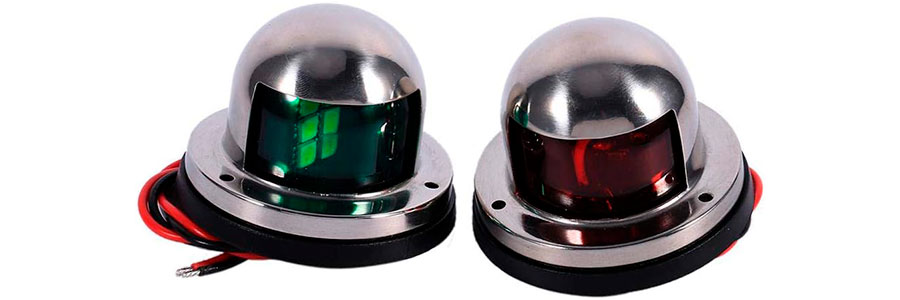
The Importance of Compliance and Understanding: Navigating the Waters of Maritime Safety
In the vast expanse of the open waters, the beacon of compliance and understanding shines as the guiding light for maritime safety. For sailors and boaters alike, adhering to the regulations governing navigation lights is not merely a legal obligation but a fundamental aspect of ensuring the safety of all vessels navigating the dark or fog-shrouded seas.
Anchored in Safety
The intricate dance of vessels at night, from the smallest dinghy to the largest tanker, relies on a shared language of lights. This luminous dialogue allows mariners to convey their presence, course, and type of vessel, preventing collisions and misunderstandings that could lead to catastrophic outcomes.
- Legal Mandates and Safety: Compliance with navigation light regulations, as outlined by the US Coast Guard and international maritime organizations, is not just a matter of following the law; it's about contributing to a safety culture that protects everyone on the water.
- Enlightenment Through Understanding: Beyond mere compliance, the understanding of navigation light configurations enhances situational awareness. Being able to quickly interpret the lights of an approaching vessel allows for timely and appropriate navigational decisions, reducing the risk of close-quarters situations or accidents. This knowledge is particularly crucial in busy or confined waters, where reaction times and clear communication are paramount.
Navigational Prudence
The vast and open sea, under the cloak of night, becomes a realm where light dictates right of way. Mariners must equip themselves with not only the lights required by their vessel's type and size but also with the knowledge of what these lights convey to others.
- Proactive Learning: It is incumbent upon vessel operators to educate themselves and their crew about the significance of different light configurations. This education should extend beyond their own vessel's requirements to include an understanding of what different light setups signify about other vessels' actions and priorities.
- Adjustments and Maintenance: Compliance also means ensuring that navigation lights are correctly positioned, functioning, and visible according to the stipulated ranges. Regular checks and maintenance prevent malfunctions that could render a vessel invisible or misleadingly represented in the eyes of others.
In the realm of maritime navigation, the array of required lights on a vessel is designed not just for compliance but for the vital purpose of communication and safety. Among these, the masthead light must be positioned prominently at the forward part of the vessel, shining forward to signal the boat’s direction and presence. This light, along with sidelights and a stern light, forms a full circle of visibility, essential for ensuring that all aspects of the boat are visible to others on the water.
For boats less than 39.4 feet, the rules adapt slightly; such vessels are required to display an all-around white light when anchored, which must be visible for at least two miles. This all-around white light also serves as a stern light when the boat is underway, often paired with sidelights that illuminate red to port and green to starboard. These lights, whether fixed or portable, must meet stringent visibility and placement requirements to ensure they accurately convey the vessel’s orientation and movement.
Furthermore, the combination of a masthead light and a stern light is pivotal when navigating between sunset and sunrise or during periods of reduced visibility. These lights not only help in adhering to the basic rules of the road but also facilitate a safer passage through busy or treacherous waters. Understanding and correctly displaying navigation lights is fundamental, allowing mariners to interpret the signals of others and navigate safely, thus fulfilling both the letter and the spirit of maritime safety regulations.
The sea, in its timeless majesty, holds enough space for all who navigate its breadth. Yet, this shared resource comes with shared responsibilities. Each vessel's lights are a voice in the chorus of maritime safety, a signal to others of its presence and purpose. Compliance and understanding of navigation light regulations are the harmonies that keep this chorus in tune, preventing discordant notes that could lead to tragedy.

